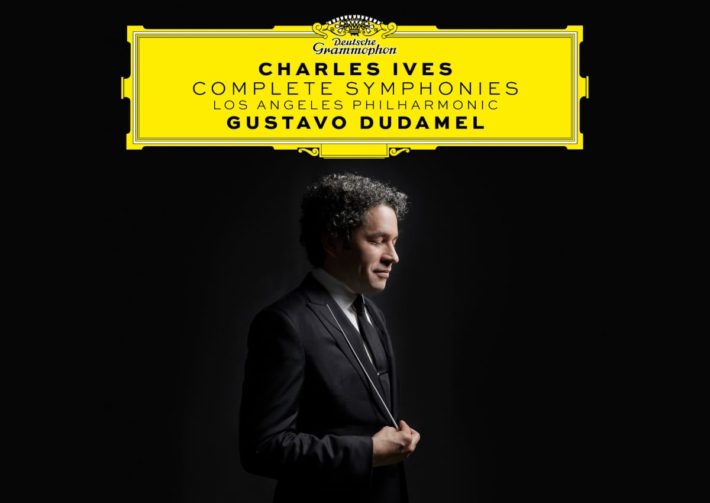Dudamel, the Los Angeles Philharmonic and DG deserve our warmest thanks for releasing new recordings of these endlessly fascinating works. The label “Complete Symphonies” is misleading however, since the “New England Holidays” Symphony is not included. Given the excellence of these performances, I hope Dudamel and Los Angeles turn their attention to that work in the future. Nevertheless, it is fantastic that one of America’s finest orchestras has recorded this repertoire.
Dudamel’s enthusiasm for, and belief in, this music is readily apparent. He ensures Ives’ oft-times dense counterpoint is rendered with an almost forensic clarity. The composer’s melodic ‘collaging’ of hymn, folk and band tunes float in and out of the aural picture in a completely natural way – a key ingredient to any successful Ives performance. Los Angeles plays with an ardent intensity that almost matches the spirit of Bernstein’s recordings. The string playing is often breathtaking, playing with unanimous precision and power throughout. Woodwinds offer playing of great beauty and character, although they are occasionally too recessed behind the strings. Brass play with richly burnished tone, the horns especially impressive, and percussion has startling immediacy. Turn the volume up and you will not only hear but feel the bass drum thwacks.
Ives’ first symphony was written as a graduation assignment for Horatio Parker, his musically conservative teacher at Yale. In his effort to follow all the structures set out by Parker, the symphony is sometimes considered too conventional and therefore not truly “Ivesian.” But Dudamel revels in its tunefulness and uncovers the playful character of the first movement. Impressive too, is the atmosphere of utter tranquility he distills in the middle section (4’50”). The following Adagio, with its gently shifting harmonies and memorable English Horn writing (ravishingly played) certainly suggests Ives knew Dvorak’s final symphony. The third movement, dispatched with a winning impishness, seems like a distant relative of Mendelssohn’s Midsummer’s Night music, while the last movement provides many moments for the Los Angeles players to show off their virtuosic brilliance.
Related Classical Music Reviews
- Review: Franz Schmidt – Complete Symphonies – Paavo Järvi
- Review: Rouse – Symphony No. 5 – Nashville Symphony, Guerrero
- Review: Prokofiev – Symphony No. 5 – Oslo Philharmonic, Petrenko
Ives’ second symphony was premiered by Bernstein and the New York Philharmonic in 1951. These same forces released a recording of the work in 1958, and that album has rarely, if ever, been out of the catalogue. While it is perhaps impossible to hope that anyone will match the zealous advocacy heard on that recording, Dudamel and Los Angeles come close. And DG’s sound is much more satisfying, allowing us to hear so much more compositional detail. As might be expected, Bernstein allows himself more rubato and shapes the music with a heavier hand. Dudamel’s interpretation is lighter and more refined, convincing most of the time, although I occasionally missed Bernstein’s more rugged, extrovert approach. There is also an unconvincing interpretative misstep in the final movement’s coda, as Dudamel needlessly speeds up for the final statement of “Columbia, Gem of the Ocean,” robbing the music of the nobility it has under Bernstein and Tilson Thomas.
The third symphony is the shortest of the five and utilizes the smallest orchestra. Dudamel and his players find the emotional essence of each movement in an intimate, graceful, and subtle reading. Dudamel seems to use some, but not all, of the shadow melodies restored in Kenneth Singleton’s 1990 critical edition of the work. These ‘shadow lines’ were written in pencil in the original manuscript and Ives decided to remove them from the first printing. Occurring in about 20 percent of the score, these shadow lines mirror an important melody with a similarly shaped chromatic line, played far more softly. One example is heard at the end of the first movement (6’39”) although in this instance, the shadowing seems too loud.
Symphony No. 4 is surely the most challenging work of the four: it is pervasively dissonant, utilizes fragmented melodic writing and lacks traditional development, making it difficult to grasp Ives’ intent. Here the composer is taking different threads, made up of various colors and materials, and weaving them into his transcendental vision of the world. Dudamel is an exceptionally perceptive guide, leading us through the music’s constantly varying soundscape. His reading of the third movement fugue is convincingly original: the music is often played with an “American pioneer” sturdiness, but here it is played with a gentle vulnerability that is deeply moving. Another striking aspect is Dudamel’s treatment of the percussion in the final movement. The percussion is more present in the aural picture, and the performance of Ives’ complex polyrhythms immediately made me think of another piece in Dudamel’s repertoire: Revueltas’ Sensemaya. Dudamel ensures the final moments are touchingly ethereal, without eclipsing memories of Tilson Thomas’s profoundly touching Chicago recording.
Despite a few trifling caveats, this is a most impressive set. The Los Angeles Philharmonic cover themselves in glory, and we can only hope these forces will go on to record the Orchestral Suites and Holidays symphony in the future. Urgently recommended.

Charles Ives – Complete Symphonies
Los Angeles Philharmonic Orchestra
Gustavo Dudamel – Conductor
Deutsche Grammophon, CD 4839505
Charles Ives Symphonies – Recommended Comparisons
Read more classical music reviews or visit The Classic Review Amazon store
Follow Us and Comment:
[wd_hustle id=”HustlePostEmbed” type=”embedded”]











